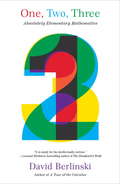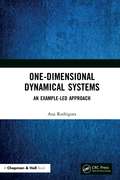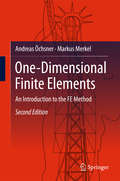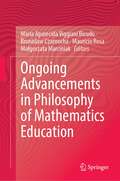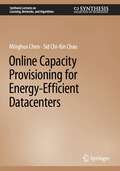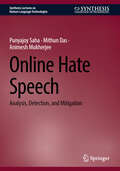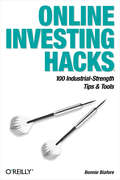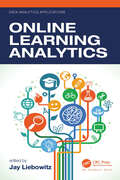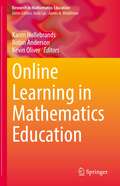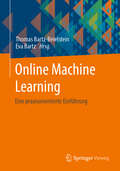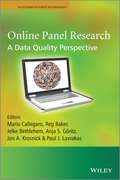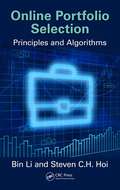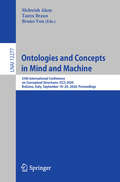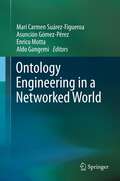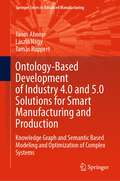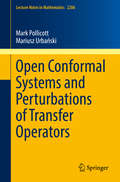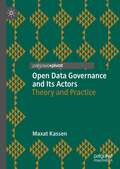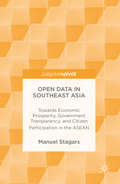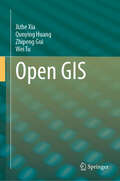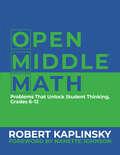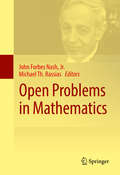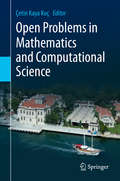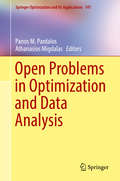- Table View
- List View
One, Two, Three: Absolutely Elementary Mathematics
by David BerlinskiFrom the acclaimed author of A Tour of the Calculus and The Advent of the Algorithm, here is a riveting look at mathematics that reveals a hidden world in some of its most fundamental concepts. In his latest foray into mathematics, David Berlinski takes on the simplest questions that can be asked: What is a number? How do addition, subtraction, multiplication, and division actually work? What are geometry and logic? As he delves into these subjects, he discovers and lucidly describes the beauty and complexity behind their seemingly simple exteriors, making clear how and why these mercurial, often slippery concepts are essential to who we are. Filled with illuminating historical anecdotes and asides on some of the most fascinating mathematicians through the ages, One, Two, Three is a captivating exploration of the foundation of mathematics: how it originated, who thought of it, and why it matters.From the Hardcover edition.
One-Dimensional Dynamical Systems: An Example-Led Approach
by Ana RodriguesFor almost every phenomenon in physics, chemistry, biology, medicine, economics, and other sciences, one can make a mathematical model that can be regarded as a dynamical system. One-Dimensional Dynamical Systems: An Example-Led Approach seeks to deep-dive into α standard maps as an example-driven way of explaining the modern theory of the subject in a way that will be engaging for students. Features Example-driven approach Suitable as supplementary reading for a graduate or advanced undergraduate course in dynamical systems
One-Dimensional Finite Elements: An Introduction To The Fe Method
by Andreas Öchsner Markus MerkelThis textbook presents finite element methods using exclusively one-dimensional elements. It presents the complex methodology in an easily understandable but mathematically correct fashion. The approach of one-dimensional elements enables the reader to focus on the understanding of the principles of basic and advanced mechanical problems. The reader will easily understand the assumptions and limitations of mechanical modeling as well as the underlying physics without struggling with complex mathematics. Although the description is easy, it remains scientifically correct.The approach using only one-dimensional elements covers not only standard problems but allows also for advanced topics such as plasticity or the mechanics of composite materials. Many examples illustrate the concepts and problems at the end of every chapter help to familiarize with the topics. Each chapter also includes a few exercise problems, with short answers provided at the end of the book.The second edition appears with a complete revision of all figures. It also presents a complete new chapter special elements and added the thermal conduction into the analysis of rod elements. The principle of virtual work has also been introduced for the derivation of the finite-element principal equation.
Ongoing Advancements in Philosophy of Mathematics Education
by Bronislaw Czarnocha Maria Aparecida Viggiani Bicudo Maurício Rosa Małgorzata MarciniakOngoing Advancements in Philosophy of Mathematics Education approaches the philosophy of mathematics education in a forward movement, analyzing, reflecting, and proposing significant contemporary themes in the field of mathematics education. The theme that gives life to the book is philosophy of mathematics education understood as arising from the intertwining between philosophy of mathematics and philosophy of education which, through constant analytical and reflective work regarding teaching and learning practices in mathematics, is materialized in its own discipline, philosophy of mathematics education. This is the field of investigation of the chapters in the book. The chapters are written by an international cohort of authors, from a variety of countries, regions, and continents. Some of these authors work with philosophical and psychological foundations traditionally accepted by Western civilization. Others expose theoretical foundations based on a new vision and comprising innovative approaches to historical and present-day issues in educational philosophy. The final third of the book is devoted to these unique and innovative research stances towards important and change resistant societal topics such as racism, technology gaps, or the promotion of creativity in the field of mathematics education.
Online Capacity Provisioning for Energy-Efficient Datacenters (Synthesis Lectures on Learning, Networks, and Algorithms)
by Minghua Chen Sid Chi-Kin ChauThis book addresses the urgent issue of massive and inefficient energy consumption by data centers, which have become the largest co-located computing systems in the world and process trillions of megabytes of data every second. Dynamic provisioning algorithms have the potential to be the most viable and convenient of approaches to reducing data center energy consumption by turning off unnecessary servers, but they incur additional costs from being unable to properly predict future workload demands that have only recently been mitigated by advances in machine-learned predictions.This book explores whether it is possible to design effective online dynamic provisioning algorithms that require zero future workload information while still achieving close-to-optimal performance. It also examines whether characterizing the benefits of utilizing the future workload information can then improve the design of online algorithms with predictions in dynamic provisioning. The book specifically develops online dynamic provisioning algorithms with and without the available future workload information. Readers will discover the elegant structure of the online dynamic provisioning problem in a way that reveals the optimal solution through divide-and-conquer tactics. The book teaches readers to exploit this insight by showing the design of two online competitive algorithms with competitive ratios characterized by the normalized size of a look-ahead window in which exact workload prediction is available.
Online Hate Speech: Analysis, Detection, and Mitigation (Synthesis Lectures on Human Language Technologies)
by Animesh Mukherjee Punyajoy Saha Mithun DasThis book informs readers on how to understand, detect, and mitigate hate speech in online social media. The authors first cover the definition of hate speech and how its prevalence can be measured on online social media platforms using text and graph-based methods. The book then describes the process of detecting hate speech and presents a comprehensive account of the AI models that are currently being used. Further, the authors discuss the associated challenges that must be overcome while using these models. The book concludes with an overview of the mitigation techniques for hate speech, including blocking or suspension of the accounts (hard technique) and counterspeech (soft technique), and a discussion of the effects of these techniques on social media platforms.
Online Investing Hacks: 100 Industrial-Strength Tips & Tools
by Bonnie BiaforeFor the geek who's an investor, and the investor who's a geek, we present Online Investing Hacks, 100 industrial-strength, bleeding edge tips, tools and techniques for analyzing and managing online portfolios.Individual investors have become more computer-literate and technology-dependent than ever before. Whether you're looking for suitable investments, studying alternatives, or managing your portfolios, you need data. The Internet can be a goldmine of financial data and research, but today's online investors also use spreadsheets, databases, and financial applications to select, study and manage investments. If your proficiency has grown to the point where you crave industrial-strength tips and tools to turbo-charge your efforts, this is the book for you.Online Investing Hacks covers:Screening InvestmentsCollecting DataFundamental AnalysisTechnical AnalysisExecuting TradesInvesting in Mutual FundsPortfolio ManagementUpdating Stock DataFinancial PlanningOther books for managing online investing are either out of date, are for beginners and don't go beyond the most basic advice, or are so dull and boring they squeeze that last bit of fun out of the topic. Online Investing Hacks is for the customer who wants to know the latest techniques, to go beyond the basics, who gets jazzed by cool online tools and services, and who actually wants to have a bit of fun while trying to strike it rich (or at least not lose their shirt).
Online Learning Analytics (Data Analytics Applications)
by Jay Liebowitz"In our increasingly digitally enabled education world, analytics used ethically, strategically, and with care holds the potential to help more and more diverse students be more successful on higher education journeys than ever before. Jay Liebowitz and a cadre of the fields best ‘good trouble’ makers in this space help shine a light on the possibilities, potential challenges, and the power of learning together in this work." —Mark David Milliron, Ph.D., Senior Vice President and Executive Dean of the Teachers College, Western Governors University Due to the COVID-19 pandemic and its aftereffects, we have begun to enter the "new normal" of education. Instead of online learning being an "added feature" of K–12 schools and universities worldwide, it will be incorporated as an essential feature in education. There are many questions and concerns from parents, students, teachers, professors, administrators, staff, accrediting bodies, and others regarding the quality of virtual learning and its impact on student learning outcomes. Online Learning Analytics is conceived on trying to answer the questions of those who may be skeptical about online learning. Through better understanding and applying learning analytics, we can assess how successful learning and student/faculty engagement, as examples, can contribute towards producing the educational outcomes needed to advance student learning for future generations. Learning analytics has proven to be successful in many areas, such as the impact of using learning analytics in asynchronous online discussions in higher education. To prepare for a future where online learning plays a major role, this book examines: Data insights for improving curriculum design, teaching practice, and learning Scaling up learning analytics in an evidence-informed way The role of trust in online learning. Online learning faces very real philosophical and operational challenges. This book addresses areas of concern about the future of education and learning. It also energizes the field of learning analytics by presenting research on a range of topics that is broad and recognizes the humanness and depth of educating and learning.
Online Learning in Mathematics Education (Research in Mathematics Education)
by Kevin Oliver Robin Anderson Karen HollebrandsThis book brings together research from mathematics education and instructional design to describe the development and impact of online environments on prospective and practicing teachers’ learning to teach mathematics. The move to online learning has steadily increased over the past decade. Its most rapid movement occurring in 2020 with most instruction taking place remotely. Chapters in this book highlight issues related to teacher learning in three main contexts: formal, informal, and experiential or practice-based. This volume brings together researchers from the different but related fields of instructional design and mathematics education to engage in dialogue around how we design and study the impacts of online learning in general and online mathematics education more specifically. The book is very timely with most instruction taking place online and mathematics educators addressing challenges related to supporting teachers’ formal, informal, and experiential learning online. A chapter in each section will synthesize ideas presented by instructional designers and mathematics educators as it relates to teacher learning in each context. At the end of each section, a retrospective chapter is presented to reflect on what the different perspectives offer to better understand mathematics teacher learning in online environments. This book is of interest to mathematics educators, researchers, teacher educators, professional development providers, and instructional designers.
Online Machine Learning: Eine praxisorientierte Einführung
by Thomas Bartz-Beielstein Eva BartzDieses Buch beschreibt Theorie und Anwendungen aus dem Bereich des Online Maschine Learnings (OML), wobei der Fokus auf Verfahren des überwachten Lernens liegt. Es werden Verfahren zur Drifterkennung und -behandlung beschrieben. Verfahren zur nachträglichen Aktualisierung der Modelle sowie Methoden zur Modellbewertung werden dargestellt. Besondere Anforderungen aus der amtlichen Statistik (unbalancierte Daten, Interpretierbarkeit, etc.) werden berücksichtigt. Aktuelle und mögliche Anwendungen werden aufgelistet. Ein Überblick über die verfügbaren Software-Tools wird gegeben. Anhand von zwei Studien (“simulierten Anwendungen”) werden Vor- und Nachteile des OML-Einsatz in der Praxis experimentell analysiert.
Online Panel Research
by Jon A. Krosnick Jelke Bethlehem Anja S. Göritz Reginald P. Baker Paul J. Lavrakas Mario CallegaroProvides new insights into the accuracy and value of online panels for completing surveysOver the last decade, there has been a major global shift in survey and market research towards data collection, using samples selected from online panels. Yet despite their widespread use, remarkably little is known about the quality of the resulting data.This edited volume is one of the first attempts to carefully examine the quality of the survey data being generated by online samples. It describes some of the best empirically-based research on what has become a very important yet controversial method of collecting data. Online Panel Research presents 19 chapters of previously unpublished work addressing a wide range of topics, including coverage bias, nonresponse, measurement error, adjustment techniques, the relationship between nonresponse and measurement error, impact of smartphone adoption on data collection, Internet rating panels, and operational issues.The datasets used to prepare the analyses reported in the chapters are available on the accompanying website: www.wiley.com/go/online_panelCovers controversial topics such as professional respondents, speeders, and respondent validation.Addresses cutting-edge topics such as the challenge of smartphone survey completion, software to manage online panels, and Internet and mobile ratings panels.Discusses and provides examples of comparison studies between online panels and other surveys or benchmarks.Describes adjustment techniques to improve sample representativeness.Addresses coverage, nonresponse, attrition, and the relationship between nonresponse and measurement error with examples using data from the United States and Europe.Addresses practical questions such as motivations for joining an online panel and best practices for managing communications with panelists.Presents a meta-analysis of determinants of response quantity.Features contributions from 50 international authors with a wide variety of backgrounds and expertise.This book will be an invaluable resource for opinion and market researchers, academic researchers relying on web-based data collection, governmental researchers, statisticians, psychologists, sociologists, and other research practitioners.
Online Portfolio Selection: Principles and Algorithms
by Bin Li Steven Chu HoiWith the aim to sequentially determine optimal allocations across a set of assets, Online Portfolio Selection (OLPS) has significantly reshaped the financial investment landscape. Online Portfolio Selection: Principles and Algorithms supplies a comprehensive survey of existing OLPS principles and presents a collection of innovative strategies that leverage machine learning techniques for financial investment.The book presents four new algorithms based on machine learning techniques that were designed by the authors, as well as a new back-test system they developed for evaluating trading strategy effectiveness. The book uses simulations with real market data to illustrate the trading strategies in action and to provide readers with the confidence to deploy the strategies themselves. The book is presented in five sections that: Introduce OLPS and formulate OLPS as a sequential decision task Present key OLPS principles, including benchmarks, follow the winner, follow the loser, pattern matching, and meta-learning Detail four innovative OLPS algorithms based on cutting-edge machine learning techniques Provide a toolbox for evaluating the OLPS algorithms and present empirical studies comparing the proposed algorithms with the state of the art Investigate possible future directions Complete with a back-test system that uses historical data to evaluate the performance of trading strategies, as well as MATLAB® code for the back-test systems, this book is an ideal resource for graduate students in finance, computer science, and statistics. It is also suitable for researchers and engineers interested in computational investment.Readers are encouraged to visit the authors’ website for updates: http://olps.stevenhoi.org.
Onramp To Algebra 2013 Positive And Negative Numbers (Student Edition Grades 7/9)
by Prentice HallonRamp to Algebra is an intervention program designed exclusively to ensure that at-risk students are adequately prepared for Algebra 1. The program is ideally implemented the year prior, to build and solidify foundational skills and conceptual understanding necessary to be successful in Algebra 1. onRamp to Algebra is a complete instructional system that utilizes technology to deliver online homework support and in-class presentation screens for whole class participation. Although the program can be implemented solely with the printed Student and Teacher editions, it is optimized when coupled with in-class technology such as whiteboards/projectors; as well as when students access its online learning aids, which provide scaffolded, point-of-use homework support. As such, the program is designed to grow with your schools' Technology Plan. onRamp to Algebra is designed to be delivered in a single block class period. Each of the 112 lessons utilizes a classroom Workshop Model, designed to ensure that your formerly struggling students are constantly active, and engaged, participants throughout the entire 45-minute class. Built-in "Coach" supports (throughout the Teachers Edition), along with a Program Overview & Implementation Guide, and onsite and/or online Professional Development, ensure that all teachers are successful in the implementation of this program.
Ontologies and Concepts in Mind and Machine: 25th International Conference on Conceptual Structures, ICCS 2020, Bolzano, Italy, September 18–20, 2020, Proceedings (Lecture Notes in Computer Science #12277)
by Mehwish Alam Tanya Braun Bruno YunThis book constitutes the proceedings of the 25th International Conference on Conceptual Structures, ICCS 2020, held in Bolzano, Italy, in September 2020.* The 10 full papers, 5 short papers and 1 poster paper presented were carefully reviewed and selected from 24 submissions. The proceedings also include two keynotes and two tutorials. The papers focus on the representation of and reasoning with conceptual structures in a variety of contexts. The topics of this year's conference range from formal concept analysis to decision making, from machine learning to natural language processing. *The conference was held virtually due to the COVID-19 pandemic.
Ontology Engineering in a Networked World
by Aldo Gangemi Asunción Gómez-Pérez Enrico Motta Mari Carmen Suárez-FigueroaThe Semantic Web is characterized by the existence of a very large number of distributed semantic resources, which together define a network of ontologies. These ontologies in turn are interlinked through a variety of different meta-relationships such as versioning, inclusion, and many more. This scenario is radically different from the relatively narrow contexts in which ontologies have been traditionally developed and applied, and thus calls for new methods and tools to effectively support the development of novel network-oriented semantic applications. This book by Suárez-Figueroa et al. provides the necessary methodological and technological support for the development and use of ontology networks, which ontology developers need in this distributed environment. After an introduction, in its second part the authors describe the NeOn Methodology framework. The book's third part details the key activities relevant to the ontology engineering life cycle. For each activity, a general introduction, methodological guidelines, and practical examples are provided. The fourth part then presents a detailed overview of the NeOn Toolkit and its plug-ins. Lastly, case studies from the pharmaceutical and the fishery domain round out the work. The book primarily addresses two main audiences: students (and their lecturers) who need a textbook for advanced undergraduate or graduate courses on ontology engineering, and practitioners who need to develop ontologies in particular or Semantic Web-based applications in general. Its educational value is maximized by its structured approach to explaining guidelines and combining them with case studies and numerous examples. The description of the open source NeOn Toolkit provides an additional asset, as it allows readers to easily evaluate and apply the ideas presented.
Ontology-Based Development of Industry 4.0 and 5.0 Solutions for Smart Manufacturing and Production: Knowledge Graph and Semantic Based Modeling and Optimization of Complex Systems (Springer Series in Advanced Manufacturing)
by János Abonyi László Nagy Tamás RuppertThis book presents a comprehensive framework for developing Industry 4.0 and 5.0 solutions through the use of ontology modeling and graph-based optimization techniques. With effective information management being critical to successful manufacturing processes, this book emphasizes the importance of adequate modeling and systematic analysis of interacting elements in the era of smart manufacturing. The book provides an extensive overview of semantic technologies and their potential to integrate with existing industrial standards, planning, and execution systems to provide efficient data processing and analysis. It also investigates the design of Industry 5.0 solutions and the need for problem-specific descriptions of production processes, operator skills and states, and sensor monitoring in intelligent spaces. The book proposes that ontology-based data can efficiently represent enterprise and manufacturing datasets. The book is divided into two parts: modeling and optimization. The semantic modeling part provides an overview of ontologies and knowledge graphs that can be used to create Industry 4.0 and 5.0 applications, with two detailed applications presented on a reproducible industrial case study. The optimization part of the book focuses on network science-based process optimization and presents various detailed applications, such as graph-based analytics, assembly line balancing, and community detection. The book is based on six key points: the need for horizontal and vertical integration in modern industry; the potential benefits of integrating semantic technologies into ERP and MES systems; the importance of optimization methods in Industry 4.0 and 5.0 concepts; the need to process large amounts of data while ensuring interoperability and re-usability factors; the potential for digital twin models to model smart factories, including big data access; and the need to integrate human factors in CPSs and provide adequate methods to facilitate collaboration and support shop floor workers.
Open Conformal Systems and Perturbations of Transfer Operators (Lecture Notes in Mathematics #2206)
by Mark Pollicott Mariusz UrbańskiThe focus of this book is on open conformal dynamical systems corresponding to the escape of a point through an open Euclidean ball. The ultimate goal is to understand the asymptotic behavior of the escape rate as the radius of the ball tends to zero. In the case of hyperbolic conformal systems this has been addressed by various authors. The conformal maps considered in this book are far more general, and the analysis correspondingly more involved. The asymptotic existence of escape rates is proved and they are calculated in the context of (finite or infinite) countable alphabets, uniformly contracting conformal graph-directed Markov systems, and in particular, conformal countable alphabet iterated function systems. These results have direct applications to interval maps, rational functions and meromorphic maps. Towards this goal the authors develop, on a purely symbolic level, a theory of singular perturbations of Perron--Frobenius (transfer) operators associated with countable alphabet subshifts of finite type and Hölder continuous summable potentials. This leads to a fairly full account of the structure of the corresponding open dynamical systems and their associated surviving sets.
Open Data Governance and Its Actors: Theory and Practice (Studies in National Governance and Emerging Technologies)
by Maxat KassenThis book combines theoretical and practical knowledge about key actors and driving forces that help to initiate and advance open data governance. Using Finland and Sweden as case studies, it sheds light on the roles of key actors in the open data movement, enabling researchers to understand the key operational elements of data-driven governance. Examining the most salient manifestations of related networking activities, the motivations of stakeholders, and the political and socioeconomic readiness of the public, private and civic sectors to advance such policies, it will appeal to e-government experts, policymakers and political scientists, as well as academics and students of public administration, public policy, and open data governance.
Open Data in Southeast Asia
by Manuel StagarsThis book exploresthe power of greater openness, accountability, and transparency in digitalinformation and government data for the nations of Southeast Asia. The author demonstratesthat, although the term "open data" seems to be self-explanatory, it involvesan evolving ecosystem of complex domains. Through empirical case studies, thisbook explains how governments in the ASEAN may harvest the benefits of opendata to maximize their productivity, efficiency and innovation. The book alsoinvestigates how increasing digital divides in the population, boundaries tocivil society, and shortfalls in civil and political rights threaten to arrestopen data in early development, which may hamper post-2015 development agendasin the region. With robust open data policies and clear roadmaps, member statesof the ASEAN can harvest the promising opportunities of open data in theirparticular developmental, institutional and legal settings. Governments, policymakers, entrepreneurs and academics will gain a clearer understanding of the factorsthat enable open data from this timely research.
Open GIS
by Qunying Huang Jizhe Xia Zhipeng Gui Wei TuThis book provides a comprehensive introduction about recent state-of-the-art advancements in Open GIS, including Open GIS data, services, software, and libraries for GIS programming. Though GIS software has entered the era of Open GIS alongside the emerging trend of open source software, there is no suitable book for GIS educators to teach our next generation, and for professionals to gain an in-depth understanding about Open GIS technologies and toolkits. This book intends to provide this missing guidance for students, educators and professionals in geospatial fields to quickly find, learn and use a wide arrange of open-sourced data, tools, and programming for geospatial applications. The book begins with an introduction to open data, and discusses data management solutions, including both open-sourced relational databases and NoSQL database systems for big data. Next, the book covers different GIS and remote sensing software, tools and programminglibraries to perform spatial statistics and analyses. Readers will learn about the tools and libraries for desktop and web GIS development for both two dimensional (2D) and three dimensional (3D) mapping and visualization. Finally, the book provides two example of Open GIS applications including public health and natural hazards. At the end of each chapter, practical hands-on exercises are included for readers to fully master the most popular Open GIS technologies introduced in the chapter.
Open Middle Math: Problems That Unlock Student Thinking, 6-12
by Robert KaplinskyThis book is an amazing resource for teachers who are struggling to help students develop both procedural fluency and conceptual understanding.. --Dr. Margaret (Peg) Smith, co-author of5 Practices for Orchestrating Productive Mathematical Discussions Robert Kaplinsky, the co-creator of Open Middle math problems, brings hisnew class of tasks designed to stimulate deeper thinking and lively discussion among middle and high school students in Open Middle Math: Problems That Unlock Student Thinking, Grades 6-12. The problems are characterized by a closed beginning,- meaning all students start with the same initial problem, and a closed end,- meaning there is only one correct or optimal answer. The key is that the middle is open- in the sense that there are multiple ways to approach and ultimately solve the problem. These tasks have proven enormously popular with teachers looking to assess and deepen student understanding, build student stamina, and energize their classrooms. Professional Learning Resource for Teachers: Open Middle Math is an indispensable resource for educators interested in teaching student-centered mathematics in middle and high schools consistent with the national and state standards. Sample Problems at Each Grade: The book demonstrates the Open Middle concept with sample problems ranging from dividing fractions at 6th grade to algebra, trigonometry, and calculus. Teaching Tips for Student-Centered Math Classrooms: Kaplinsky shares guidance on choosing problems, designing your own math problems, and teaching for multiple purposes, including formative assessment, identifying misconceptions, procedural fluency, and conceptual understanding. Adaptable and Accessible Math: The tasks can be solved using various strategies at different levels of sophistication, which means all students can access the problems and participate in the conversation. Open Middle Math will help math teachers transform the 6th -12th grade classroom into an environment focused on problem solving, student dialogue, and critical thinking.
Open Middle Math: Problems That Unlock Student Thinking, 6-12
by Robert KaplinskyThis book is an amazing resource for teachers who are struggling to help students develop both procedural fluency and conceptual understanding.. --Dr. Margaret (Peg) Smith, co-author of5 Practices for Orchestrating Productive Mathematical Discussions Robert Kaplinsky, the co-creator of Open Middle math problems, brings hisnew class of tasks designed to stimulate deeper thinking and lively discussion among middle and high school students in Open Middle Math: Problems That Unlock Student Thinking, Grades 6-12. The problems are characterized by a closed beginning,- meaning all students start with the same initial problem, and a closed end,- meaning there is only one correct or optimal answer. The key is that the middle is open- in the sense that there are multiple ways to approach and ultimately solve the problem. These tasks have proven enormously popular with teachers looking to assess and deepen student understanding, build student stamina, and energize their classrooms. Professional Learning Resource for Teachers: Open Middle Math is an indispensable resource for educators interested in teaching student-centered mathematics in middle and high schools consistent with the national and state standards. Sample Problems at Each Grade: The book demonstrates the Open Middle concept with sample problems ranging from dividing fractions at 6th grade to algebra, trigonometry, and calculus. Teaching Tips for Student-Centered Math Classrooms: Kaplinsky shares guidance on choosing problems, designing your own math problems, and teaching for multiple purposes, including formative assessment, identifying misconceptions, procedural fluency, and conceptual understanding. Adaptable and Accessible Math: The tasks can be solved using various strategies at different levels of sophistication, which means all students can access the problems and participate in the conversation. Open Middle Math will help math teachers transform the 6th -12th grade classroom into an environment focused on problem solving, student dialogue, and critical thinking.
Open Problems in Mathematics
by Jr. John Forbes Forbes Nash Michael Th. Th. RassiasThe goal in putting together this unique compilation was to presentthe current status of the solutions to some of the most essential open problemsin pure and applied mathematics. Emphasis is also given to problems ininterdisciplinary research for which mathematics plays a key role. This volume comprises highly selected contributions by some of the mosteminent mathematicians in the international mathematical community onlongstanding problems in very active domains of mathematical research. A jointpreface by the two volume editors is followed by a personal farewell to John F. Nash, Jr. written by Michael Th. Rassias. An introduction by Mikhail Gromovhighlights some of Nash's legendary mathematical achievements. The treatment in this book includes open problems inthe following fields: algebraic geometry, number theory, analysis, discretemathematics, PDEs, differential geometry, topology, K-theory, game theory, fluidmechanics, dynamical systems and ergodic theory, cryptography, theoreticalcomputer science, and more. Extensive discussions surrounding the progress madefor each problem are designed to reach a wide community of readers, fromgraduate students and established research mathematicians to physicists,computer scientists, economists, and research scientists who are looking todevelop essential and modern new methods and theories to solve a variety ofopen problems.
Open Problems in Mathematics and Computational Science
by Çetin Kaya KoçThis book presents interesting, important unsolved problems in the mathematical and computational sciences. The contributing authors are leading researchers in their fields and they explain outstanding challenges in their domains, first by offering basic definitions, explaining the context, and summarizing related algorithms, theorems, and proofs, and then by suggesting creative solutions. The authors feel a strong motivation to excite deep research and discussion in the mathematical and computational sciences community, and the book will be of value to postgraduate students and researchers in the areas of theoretical computer science, discrete mathematics, engineering, and cryptology.
Open Problems in Optimization and Data Analysis (Springer Optimization and Its Applications #141)
by Panos M. Pardalos Athanasios MigdalasComputational and theoretical open problems in optimization, computational geometry, data science, logistics, statistics, supply chain modeling, and data analysis are examined in this book. Each contribution provides the fundamentals needed to fully comprehend the impact of individual problems. Current theoretical, algorithmic, and practical methods used to circumvent each problem are provided to stimulate a new effort towards innovative and efficient solutions. Aimed towards graduate students and researchers in mathematics, optimization, operations research, quantitative logistics, data analysis, and statistics, this book provides a broad comprehensive approach to understanding the significance of specific challenging or open problems within each discipline. The contributions contained in this book are based on lectures focused on “Challenges and Open Problems in Optimization and Data Science” presented at the Deucalion Summer Institute for Advanced Studies in Optimization, Mathematics, and Data Science in August 2016.
